Artisan bread recipes don’t get easier than this No Knead Artisan Bread recipe! This artisan bread is so easy to make, it’s practically foolproof. Perfect for sandwiches, toasting, or enjoying with soup, chili, or stew.
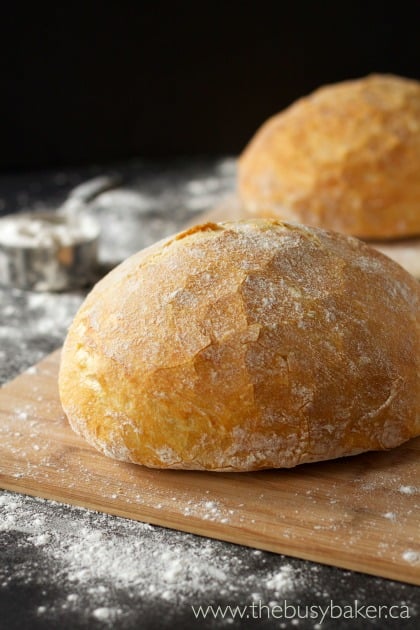
NEVER MISS A POST! FOLLOW ME ON:
FACEBOOK | PINTEREST | INSTAGRAM | TWITTER
Artisan loaves are the perfect bread to serve alongside a hot bowl of soup, stew or chili and no knead bread makes great bakery-inspired sandwiches. And it’s always a nice way to impress your friends and family…they may not believe you when you say you made it yourself!
To make this artisan bread recipe, you’ll need:
- all purpose flour
- instant yeast
- sea salt
- room temperature water
- Oven-safe Dutch oven pot with a lid – This Dutch oven is the one I use.
How to Make No Knead Bread
Some basic but important tips to know about making homemade bread:
- Before you get started, it’s important to know that the bread needs between 12 and 18 hours (or more) to rise. When I make this recipe, I always mix the dough in the afternoon or evening of the day before I’m actually going to bake the bread, so it has roughly 16-18 hours to rise.
- One tricky part of bread making is ensuring the yeast does its work to rise the dough without coming into direct contact with the salt. Salt is a very important ingredient in a bread recipe for two reasons: it works to add flavour and it retards the growth of the yeast, resulting in a more even texture than breads that contain no salt. If the yeast and the salt are mixed directly, however, (or if the recipe contains not enough yeast and too much salt) the salt can prevent the dough from rising altogether.
- When the bread is rising, don’t touch it or think about it during this time. Just leave it alone and let the yeast work. Remember, this is a no knead artisan bread recipe!
12-18 hours later…
- When it comes time to mixing the dough, if you wear rings, now would be a good time to take them off. The dough is sticky and turns into glue when it dries on any surface (Do you really want to spend your afternoon cleaning out all those crevices with an old toothbrush? Didn’t think so…)
What Type of Pan Should I Bake Artisan Bread In?
The recipe I used when I first made this bread (you can find it here) suggests that a cast iron Dutch oven pot is the best kind to use for this no knead bread recipe. However, of all the pots I’ve tried (cast iron, deep casserole dish with a glass lid, and round metal roasting pan) my round metal roasting pan has given me by far the best results with just the right amount of crispness in the crust.
Isn’t this just the most beautiful loaf of no knead artisan bread you ever did see??
NEVER MISS A POST! FOLLOW ME ON:
FACEBOOK | PINTEREST | INSTAGRAM | TWITTER
You can usually get about 10-12 slices out of a loaf, and each slice comes just a little over 100 calories! I hope you get a chance to try this artisan bread recipe soon! And when you do, be sure to let me know what you think!!
KITCHEN PRODUCTS I RECOMMEND:
Looking for even more delicious bread recipes? You’ll LOVE these:
-
No Knead Whole Wheat Artisan Bread
-
Healthier Cornbread
-
Best Ever Cinnamon Raisin Bread
-
Easy No Knead Artisan Bread
-
Easy No Knead Cinnamon Raisin Artisan Bread
-
No Knead Honey Cranberry Walnut Artisan Bread
If you made this, share a photo!
Are you trying this recipe? Use the comment form below to share your take; now with support for image uploads and comment voting!
Easy No Knead Artisan Bread
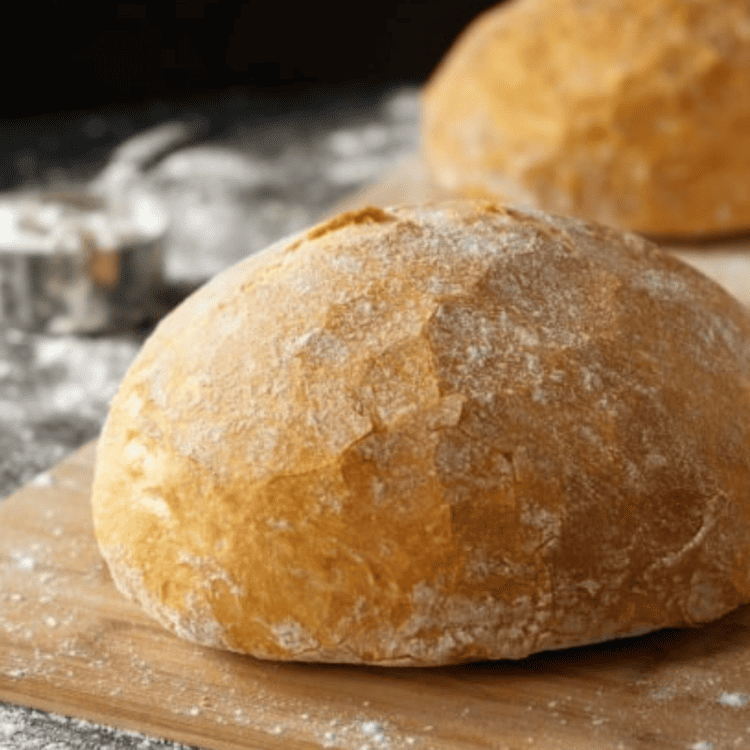
Recipe: Ingredients
- 3 cups all purpose flour
- 1/2 teaspoon instant yeast
- 2 teaspoons sea salt
- 1 1/2 cups water at room temperature
Recipe: Instructions
- Start with a large bowl and a wooden spoon, and add your flour to the bowl. Measure the yeast and add it to one side of the bowl. Measure the salt and add it to the other side.
- Using a wooden spoon, stir the yeast into the flour on its side of the bowl first and then stir the salt into the flour on its side of the bowl. This will prevent the salt mixing directly with the yeast. Give the whole mixture a few good stirs to make sure everything is combined.
- Once the dry ingredients are combined, measure the water. Make sure the water is at room temperature; water that is too warm or too cold can kill the yeast and prevent the bread from rising at all. Pour the water in and stir with a wooden spoon. The dough will be rough and a bit sticky, but that's normal.
- Stir until all the flour is combined. This is not normal bread dough (there's no kneading involved in this recipe), so you don't need to be too concerned about the appearance of the dough at this point. Just make sure the ingredients are combined well.

- Cover the bowl with plastic wrap. It's a good idea to ensure there's adequate space left in the bowl for the dough to at least double in size. Place the bowl in a warm, draft-free place and let it rise for 12-18 hours.

- After the dough has risen for 12-18 hours, preheat oven to 450 degrees Fahrenheit. Place your Dutch oven with the lid on in the cold oven and let it heat up with the oven.
- Place a piece of parchment paper on the counter and dust it with flour. Rub flour on your hands and scrape the dough away from the sides of the bowl, gathering it in your hands as best you can (it may feel kind of fluid and not at all like regular bread dough) and forming it into a circular loaf on the parchment paper. Don't worry if it still looks a little rough in places. This lends to the rustic look of this loaf.

- Once you have it shaped, the dough needs to undergo a second rise (much shorter than the first). The goal is to handle the dough as little as possible at this stage because any amount of tugging at the rough can cause it to deflate after it has undergone its second rise. The next few steps will help prevent this. But don't worry if it deflates a bit. This bread dough is pretty forgiving.

- Sprinkle flour over the top of the loaf and loosely cover it with plastic wrap to prevent a skin from forming over the dough. The flour also prevents the plastic wrap from sticking to the dough so when you take it off at the end of the rise, it doesn't disturb the dough and wreck the rustic shape you've created. Let the dough rise for about 45 minutes. Your oven will also be preheating during this time (and so will your pot).
- Once 45 minutes have passed remove the plastic wrap from the dough and trim the parchment paper into a circle closely around the dough. If it doesn't look like the dough has risen that much, don't worry about it. The loaf will puff up a bit when it hits the heat of the oven.
- Remove the preheated pot from the oven and transfer the dough into the pot as carefully as possible by handling only the parchment paper. Place the lid on the pot and return it to the oven for 30 minutes. Don't open the oven during this time, and certainly don't take the lid off the pot; the crispness of the crust develops because of the steam that builds up in the pot during this 30 minutes.

- After 30 minutes have passed, remove the lid from the pot and continue baking for another 15 minutes. After the 15 minutes have passed, remove the pot with bread from the oven and place it on a wire rack to cool. You'll probably hear it crackling as it cools - this is normal.

- If you can, resist the urge to cut into the bread until it has pretty much cooled completely. The bread continues to bake on the inside even after it has been removed from the oven and cutting it too early could result in the inside becoming gummy or rubbery.
Recipe: Notes
Quick rise method:
If you'd like to make a quick rise version of this bread, please click here for my Quick No Knead Bread Recipe.No Knead Bread Troubleshooting Tips:
- If your dough seems too fluid after the first rise, simply add 1/3 cup of flour to the top of the dough and mix it in, shaping the loaf into a round shape to rise again while the oven pre-heats.
- If your loaf falls or flattens during the second rise, simply re-shape before baking into as tight a ball as possible (creating surface tension should prevent the dough from falling).
- Add 1 tablespoon of Vital Wheat Gluten to the dough with the flour to create a very voluminous dough that rises beautifully every single time and isn't too dense.
- If the bottom crust of your bread burns or becomes too hard or tough, it's likely that the bottom burner of your oven is too hot OR you're using a pot that's black on the inside (these conduct heat more efficiently than one that's a light colour on the inside). Try lowering your oven temperature by 25 degrees, using the convection setting, or using a different pot that's light in colour on the inside.
- Use an oven thermometer to make sure your oven temperature is correct. If your oven runs hot, lower the temperature of your oven by 25 degrees to be sure you don't burn the bread.
Recipe: Nutrition
Notice: Nutrition is auto-calculated, using Spoonacular, for your convenience. Where relevant, we recommend using your own nutrition calculations.

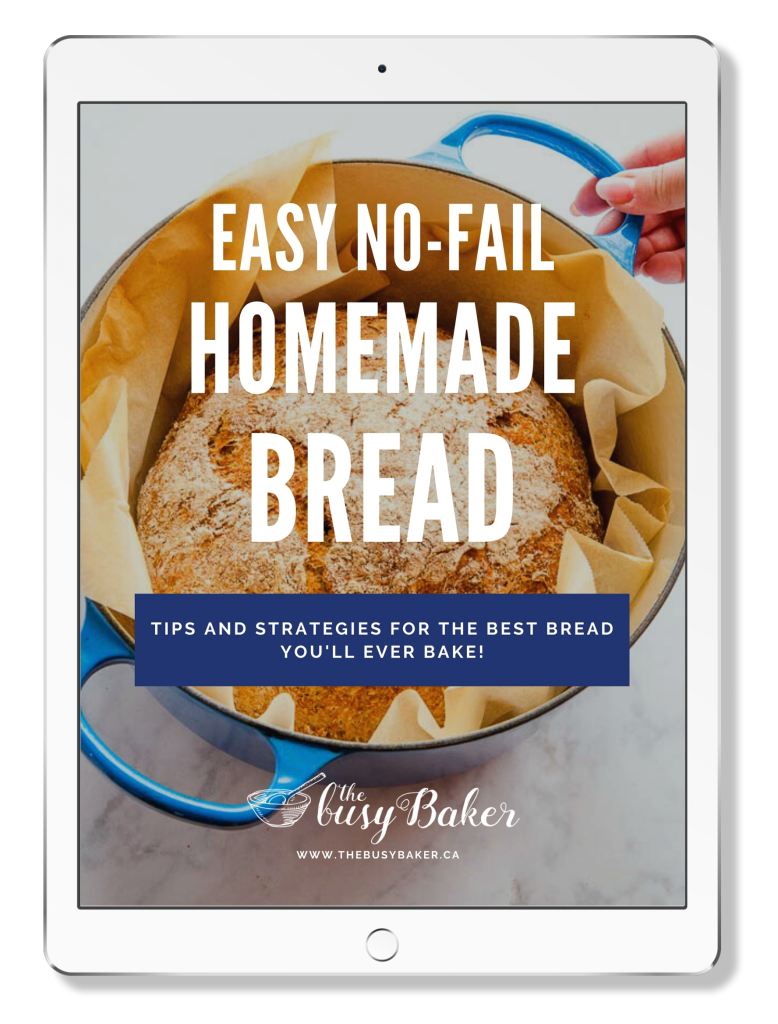


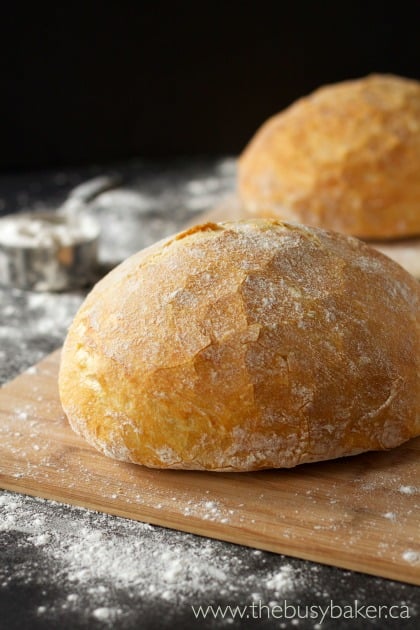
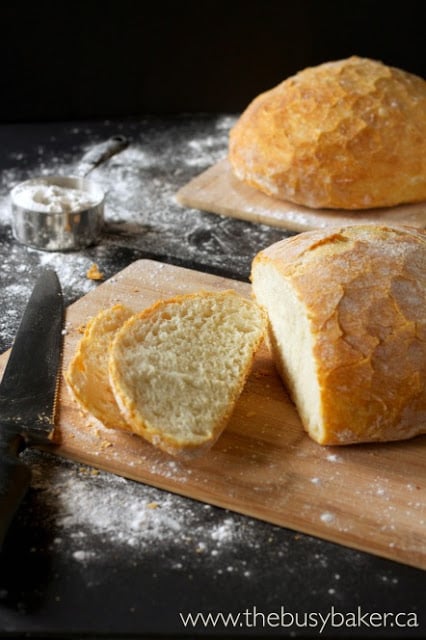






I have made bread in my LeCreuset before but I still can't get the crust crispy enough. I want to try this recipe and use my cast iron because the crust is my favorite part!!!
Cast iron works perfectly. This has become my go to recipe for bread. I leave the covered container I mixed it in in the fridge so each load is now developing the sourdough flavor that I prefer.
Hope it turned out good!
I have the first rise going at the moment….I notice that you don’t slash your loaf like other artisan breads. It won’t split?? Hoping for a response today before I get home to bake it.
Sometimes it does split, but it adds to the rustic nature of this bread 🙂
Now that is a gorgeous loaf of bread! This would be perfect as part of a Thanksgiving spread!
Thanks!
That is such a pretty loaf of bread! One of these days I'll have to try my hand at bread baking!
Thank you! Hope you enjoy it!
What a beautiful loaf of bread. I can only imagine how wonderful it smelled while baking.
Thanks!😊
I can't turn down a piece of crusty bread! You make this one look so easy!
Thank you!
Sounds amazing! My family would love this!
Thanks! Hope you enjoy it!
What stunning loaf of break! I love fresh bread, we could live on it at our house. And one that doesn't take a ton of work is perfect!
Thanks!😊
Looks amazing! Nothing better than fresh bread!
Thanks!
hi Chrissie. I baked this bread and it turned out exactly as advertised, great one. not kneading: love it.
So glad you enjoy it!
Fantastic recipe for making weekly bread. I bake it in my cast iron Dutch oven and it comes out perfect every time. You are right though. It's hard to wait until it is completely cooled to cut into it. It's just like a bakery load.
Do you leave the parchment paper on the bottom of the loaf when you are baking it?
Yes, it’s best if you do, but it’s possible without too 🙂
Can you use Gluten Free flour? Is there something I could mix with it to produce such a beautiful loaf? Guar gum, xanthan gum or other? Thank you for your kind attention ~ I love your recipes !!
I’m sorry, I’ve never made this with gluten-free flour so I can’t comment on how that would work!
Have you tried making Soft Pretzels with this dough? I would love to try but hoped you had a recipe!!
This dough wouldn’t be great for soft pretzels because it’s a hearty dough. I’m working on a soft pretzel recipe, but it’s not ready to share just yet!
I Have made this recipe many time and it has come out perfectly baked and crusty A great easy recipe..
So glad you liked it! 🙂
This recipe works exactly as you described. I, too, bake mine in a cast iron dutch oven and it comes out perfect every time. It has become a favorite weekly favorite of my boss and the(always hungry) young people who live next door. Thanks for sharing it with us!
Good for you for feeding your neighbours 😉 So glad you like the recipe! Thanks for taking the time to comment! 🙂
Hi Chrissie,
This bread looks so delish and I would love to try the recipe however I do not own a cast iron dutch oven.
What else would work to make this type of bread recipe? FYI I own anodized pots. Do you think this would work?
Looking forward for your reply, Thanks
Any type of oven-safe pot with a lid will work for this recipe. Cast iron dutch oven offer the best results, but they’re not necessary. Give it a try with any covered oven-safe pot you have 🙂
So I read on your other bread recipe several of the comments it’s the bread recipe for the cranberry walnut bread… And I did not have the instant yeast but had gotten the active dry yeast. I know in one of the comments you said that was fine but I didn’t know then if I should have put more in? I put this together last night and after now almost 9 hours it looks exactly the same as it did last night. I just bought the yeast about one day ago so there’s no way it’s old and less it was sitting in the store old but the date on it does not show expired at all. And I Checked the temperature of my water and it was just around 80° when I poured it in. And something else I had read somewhere between 70 and 85° would be considered room temperature so I assumed that that would be OK… I was planning to let it sit for many more hours today but I’m not feeling very hopeful that it is going to rise… Any input? I really hope it does it looks delicious!
So my bread definitely did not rise in the nearly 16 hours that I left it to rise. However I went ahead and did the second step and then baked it in the old black and white speckled pan that I had. Then left it to cool for several hours. I just toasted a piece and it was amazing! Thank you so much for this recipe I plan on making it many more times!!
Sorry one more question… Any idea how long this keeps even in the refrigerator? I believe you said it was best to not freeze it is that correct?
You mentioned that you very much liked the results from your round roasting pan. I have one of those. Do you have a pic you could post of a loaf baked that way?
Unfortunately I don’t have a photo, but the appearance was almost exactly the same 🙂
With everyone, myself included, staying home because of COVID-19 I started exploring recipes for no knead bread. I picked this recipe and have now made it 3 times with great results. I love the texture, chewiness, flavor and how beautiful and rustic the bread looks. And especially how easily it comes together. The change I’ve made is 1) I don’t cut the parchment paper. Once the dough has sat on the parchment the allotted time, I take pot out of oven , take top off and simply lift the whole thing up by the edges of parchment paper and place it in cast iron pot. Put lid on with parchment corners sticking out and in oven it goes. 2) I make the dough in a large glass bowl and found that I need to add extra water a few tablespoons at a time to get a wetter dough. Then put plastic wrap over top of bowl and put it in my cold oven to rise. Since I live in Colorado Springs and it’s winter time my house is colder and this is the best place to let the dough do it’s thing. I let it sit in the oven up to 24 hours and find I have a beautiful airy dough. Love it. Thank you!!
Glad to hear you liked the recipe so much! And I’m happy you were able to tweak it to your needs.😊
Made this yesterday and it was delicious! My Dutch oven is rated for 400 degrees. Baked for 40 mins covered and 17 uncovered. Delicious!! Definitely will make again and again. Thanks!!
You’re welcome Shannon! Thanks for the feedback!!
I’d really like to try this. What size Dutch oven do you recommend? 5.5 Qt or 7 Qt?
I have a 7.5 qt dutch oven that serves me very well.
I really thought I messed this up, then I tasted it. My Dutch oven is large, so my bread did not get as high. The taste is incredible! I let it rise 20 hours before baking, mostly because I didn’t want to get up early! I have a batch of plain dough on the rise now. I can’t wait to taste it! Thanks for the EASY recipe. It will become a staple at my house.
Homemade is so much better!! 🙂 Thanks Brenda!
I love all your artisan breads. Everyone of them are absolutely wonderful. Favorite is the cranberry, honey. I use pecans as I really do not like walnuts. But I cannot find anywhere a rye artisan bread from you. If you have please share.
I’m so happy you enjoyed them! Thank you for taking the time to leave your feedback! Sadly, I do not have a Rye artisan bread recipe yet, but I will add it to the list so me and the team can start working on one soon!
Could you please explain the reason for the long rise? Does it give the bread a sourdough flavor?
The long raise substitutes the kneading.
I can’t wait to make this no knead bread. I have a 2 QT Anchor Hocking glass casserole dish, will that be big enough to accommodate this recipe?